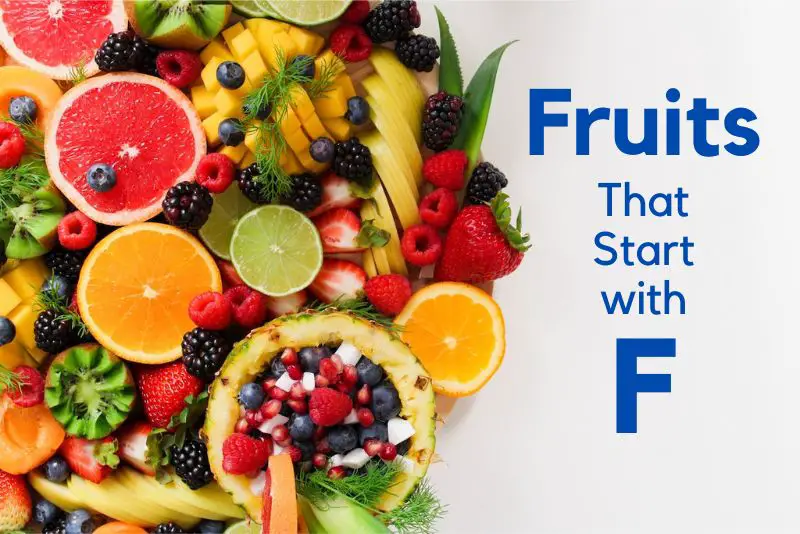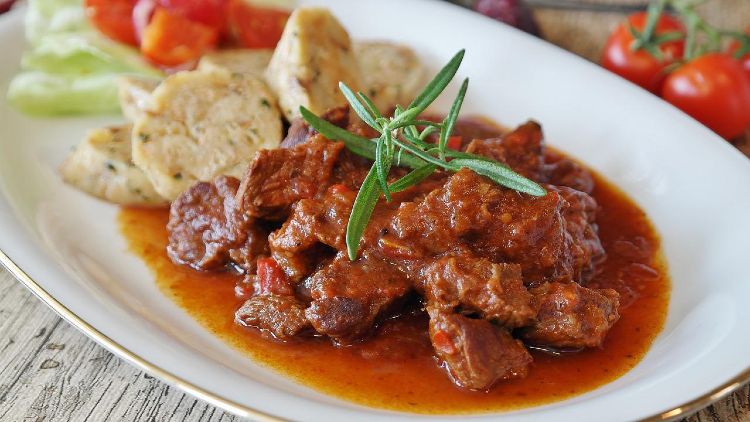Fruits That Start with F (Complete List of 30+ Fruit Names)
Fruits that start with F encompass a diverse range of flavors, textures, and appearances. From familiar favorites to exotic delicacies, these fruits offer a delightful culinary experience.
Whether it’s the sweet and juicy flesh of a fresh Fuji apple, the tangy notes of a farkleberry, or the tropical aroma of a florentine citron, each fruit brings its unique character to the table.
From forests to farms, these fruits can be found in various corners of the world, adding vibrancy and nutrition to our diets. Join us as we explore this captivating array of fruits beginning with F and discover the flavors that await.
List of Fruits Starting with F
Fairchild Tangerine
Fairchild tangerine is a small citrus fruit that belongs to the mandarin orange family. It has a vibrant orange color and a sweet, juicy taste. Fairchild tangerines are easy to peel and are packed with vitamin C and other beneficial nutrients.
They are commonly enjoyed as a healthy snack or used in salads, desserts, and beverages. Fairchild tangerines are known for their refreshing flavor and are a popular choice among citrus enthusiasts.
False Jaboticaba
False jaboticaba, scientifically known as Myrciaria vexator, is a fruit that resembles the jaboticaba but comes from a different species of tree. It has a dark purple skin and a juicy, sweet pulp. False jaboticaba fruits are often used in making jams, jellies, and wines.
They are known for their unique flavor and are enjoyed fresh or used in various culinary preparations. Trees of false jaboticaba are popular for their ornamental value, as they produce clusters of fruits directly on their trunks.
False Mastic Fruit
False mastic fruit, also called Schinus molle, is a small fruit that grows on the mastic tree. It has a reddish color and a distinct, resinous taste.
False mastic fruits are commonly used as a spice or flavoring in traditional dishes. They can add a unique and aromatic touch to culinary creations. The mastic tree is also valued for its fragrant leaves, which are sometimes used for their medicinal properties.
False Pineapple
False pineapple, also known as the pineapple guava or Feijoa, is a fruit with a green, egg-shaped exterior. It has a tropical flavor reminiscent of pineapple, combined with a hint of other fruits like strawberry and pineapple.
False pineapples have a creamy texture and are often eaten fresh or used in desserts, jams, and beverages. They are rich in vitamins and minerals, making them a healthy and delicious choice. False pineapple plants are valued for their attractive flowers and are grown in gardens for their ornamental appeal.
Farkleberry
Farkleberry, scientifically known as Vaccinium arboreum, is a small, dark purple berry that grows on a shrub. It has a mildly sweet and slightly tart taste. Farkleberries are commonly used in making jams, jellies, and pies.
They are known for their high antioxidant content and are enjoyed as a healthy snack. Farkleberry plants are native to the southeastern United States and are often foraged in the wild. They are appreciated for their natural abundance and unique flavor.
Fascell Mango
Fascell mango, also known as the Tommy Atkins mango, is a popular mango variety known for its vibrant red skin and firm, juicy flesh. It has a sweet and tropical flavor with a hint of tartness. Fascell mangoes are commonly eaten fresh, sliced, or used in smoothies, salads, and desserts.
They are widely available in many parts of the world and are prized for their consistent quality and versatile uses. Fascell mangoes are a favorite choice for mango enthusiasts and are enjoyed during the mango season.
Fazil Mango
Fazil mango is a variety of mango that originated in Pakistan. It has a golden-yellow skin with a reddish blush and a smooth, fiberless flesh. Fazil mangoes are renowned for their sweet and aromatic flavor, making them a sought-after fruit.
They are commonly eaten fresh or used in various culinary preparations, such as mango desserts, shakes, and jams. Fazil mangoes are cherished during the mango season for their exceptional taste and quality, delighting mango lovers with their juicy and flavorful characteristics.
Feijoa
Feijoa, also known as the pineapple guava, is a fruit native to South America. It has a green, egg-shaped exterior with a sweet and tangy flavor reminiscent of a blend of pineapple, banana, and mint.
Feijoa fruits have a unique texture with a gritty center and a smooth, jelly-like flesh surrounding it. They are commonly eaten fresh, scooped out with a spoon, or used in various culinary creations such as desserts, jams, and beverages. Feijoa is highly aromatic and adds a tropical twist to dishes.
Fe’i Bananas
Fe’i bananas, also called Highland bananas, are a group of bananas cultivated in the highland regions of Papua New Guinea. They are small in size and have a unique flavor that is often described as tangy and apple-like.
Fe’i bananas are consumed both ripe and cooked, and they are a staple food in the local cuisine. They are rich in potassium, vitamin C, and dietary fiber, making them a nutritious and energy-rich snack.
Fibrous Satinash Fruit
Fibrous satinash fruit, scientifically known as Syzygium fibrosum, is a fruit native to Australia. It has a greenish-yellow skin and a fibrous, somewhat dry texture. Fibrous satinash fruits have a slightly acidic taste with hints of sweetness.
They are commonly used in making jams, preserves, and sauces. The fruit is also known for its edible seeds, which have a nutty flavor. Fibrous satinash trees are valued for their ornamental beauty, with their glossy leaves and attractive fruits.
Field Cucumbers
Field cucumbers, also known as slicing cucumbers, are a variety of cucumber that is commonly grown for fresh consumption. They have a crisp texture and a mild, refreshing taste. Field cucumbers are usually larger and have a thicker skin compared to other cucumber varieties.
They are commonly sliced and added to salads, sandwiches, and pickles. Field cucumbers are rich in water content and are a healthy and hydrating snack option.
Figs
Figs are sweet and succulent fruits that come in a variety of shapes and colors. They have a unique texture with a soft, chewy flesh and tiny seeds.
Figs can be enjoyed fresh or dried and are often used in both sweet and savory dishes. They have a honey-like sweetness and pair well with cheeses, nuts, and other fruits. Figs are also a good source of fiber and essential nutrients.
Finger Lime
Finger lime, also known as caviar lime, is a small citrus fruit native to Australia. It gets its name from its elongated shape and the caviar-like pulp it contains. The pulp of finger lime is composed of tiny, juicy spheres that burst with a tangy, citrus flavor.
Finger limes come in various colors, including green, yellow, and pink. They are used as a garnish, in cocktails, and in various culinary creations where their unique texture and taste can add a delightful twist.
Five Flavor Berry
Five flavor berry, scientifically known as Schisandra chinensis, is a fruit native to East Asia. It is known for its unique taste, which combines all five basic flavors sweet, sour, bitter, salty, and umami.
Five flavor berries are used in traditional Chinese medicine for their potential health benefits and are consumed both fresh and dried. They are often made into teas, juices, or added to herbal formulations. The fruit is highly valued for its distinct flavor profile and potential medicinal properties.
Five-Leaved Bramble Berry
Five-leaved bramble berry, also called Rubus pentagonus, is a wild fruit found in North America. It belongs to the blackberry family and has a sweet and slightly tart flavor.
The fruit is small and round with a deep purple color when ripe. Five-leaved bramble berries are often foraged in the wild and used in jams, pies, and desserts. They are a rich source of antioxidants and are enjoyed for their natural sweetness and vibrant taste.
Flatwoods Plum
Flatwoods plum, scientifically known as Prunus umbellata, is a fruit native to the southeastern United States. It is a small, reddish-purple plum with a sweet and tangy flavor.
Flatwoods plums are often used in making jams, jellies, and preserves. They are also enjoyed fresh and can be used in baking or added to fruit salads. Flatwoods plum trees are valued for their ornamental beauty and are important for wildlife as a source of food.
Florentine Citron
Florentine citron, also known as cedro, is a citrus fruit that originated in the Mediterranean region. It has a large, bumpy yellow skin and a fragrant, lemon-like aroma.
Florentine citrons are primarily used for their zest, which adds a tangy and aromatic flavor to dishes, desserts, and beverages. They are also popularly candied and used in traditional Italian recipes. People love florentine citrons for their unique appearance and their contribution to culinary creations.
Florentine Crabapple
Florentine crabapple is a type of crabapple tree that produces small, tart fruits. The fruits have a bright red or yellow skin and a crisp texture.
Florentine crabapples are often used in making preserves, jellies, and sauces. They can also be added to baked goods like pies and tarts to add a tangy flavor. The tree itself is prized for its attractive spring blossoms and is commonly found in gardens and landscapes.
Florida Cherry
Florida cherry, scientifically known as Eugenia uniflora, is a small fruit that grows on a tropical shrub. It has a bright red color and a sweet-tart flavor profile.
Florida cherries are commonly eaten fresh or used in jams, jellies, and desserts. They are rich in antioxidants and vitamin C, making them a healthy snack option. Their shrubs are popular in landscaping due to their attractive appearance and the abundance of their vibrant fruits.
Florida Strangler Fig
Florida strangler fig, also called Ficus aurea, is a unique fruit-bearing tree found in the subtropical regions of Florida and other parts of the Americas. It starts as an epiphyte, growing on other trees and eventually enveloping them with its roots.
The fruits of the Florida strangler fig are small and green when ripe, with a sweet and juicy pulp. They are an important food source for various bird species and wildlife. The tree itself is an impressive sight, with its sprawling growth and intricate root system.
Fony Baobab Fruit
Fony baobab fruit comes from the baobab tree, a distinctive and iconic tree found in Africa. The fruit is large and has a hard, coconut-like shell. Inside, it contains a powdery pulp that is tangy and slightly sweet.
Fony baobab fruits are rich in vitamin C, fiber, and other essential nutrients. They are commonly used in traditional African cuisines, where the pulp is mixed with water or added to porridges, smoothies, and desserts. The baobab tree is revered for its cultural significance and its ability to thrive in harsh arid environments.
Forest Strawberry
Forest strawberry, also known as wild strawberry, is a small fruit that grows in wooded areas and meadows. It has a sweet and tangy flavor, similar to cultivated strawberries, but with a more intense aroma.
Forest strawberries are often smaller in size but are highly prized for their intense flavor. They are enjoyed fresh, added to salads, or used in jams, desserts, and beverages. Forest strawberries are a delightful find for foragers and nature enthusiasts exploring the outdoors.
Fox Grapes
Fox grapes, also called Vitis labrusca, are a variety of grapes native to North America. They have a distinctive flavor that is both sweet and tart, and their taste can vary from mildly fruity to strongly grapey.
Fox grapes are commonly used in winemaking, particularly for making grape juice, jelly, and jams. They are also enjoyed fresh and are a popular choice for snacking. Fox grapes are appreciated for their resilience and adaptability, making them a favorite among grape growers.
Fuji Apples
Fuji apples are a popular apple variety that originated in Japan. They have a sweet and crisp flesh with a hint of tartness.
Fuji apples are known for their excellent storage qualities, remaining fresh and flavorful for extended periods. They are enjoyed both fresh and in various culinary applications, including pies, salads, and sauces. They are widely available and are popular for their pleasant texture and well-balanced flavor.
Fuji Cherry
Fuji cherry, also known as Prunus incisa, is a flowering cherry tree native to Japan. It produces small, delicate cherry fruits with a bright red color and a sweet flavor.
Fuji cherries are primarily enjoyed fresh and are a popular ingredient in traditional Japanese desserts and confections. The cherry blossoms of the Fuji cherry tree are highly celebrated in Japan during the spring, attracting visitors from all over the world to witness their breathtaking beauty.
Fukushu Kumquat
Fukushu kumquat is a variety of kumquat, a small citrus fruit. It has a bright orange color and a sweet-tart flavor. Fukushu kumquats are often eaten whole, including the peel, as the peel provides a burst of citrusy aroma and flavor.
They are also used in various culinary applications, such as marmalades, preserves, and desserts. Fukushu kumquat trees are valued for their ornamental appeal and their ability to bear fruit abundantly.
In conclusion, fruits that start with the letter “F” present a fascinating assortment of flavors, textures, and colors.
Whether you’re savoring the succulent flesh of a fig, indulging in the tartness of a feijoa, or relishing the aromatic sweetness of a fony baobab fruit, these fruits provide a delightful and nutritious addition to our diets. So, next time you’re exploring the world of fruits, don’t forget to explore the enchanting realm of fruits that start with “F”.


